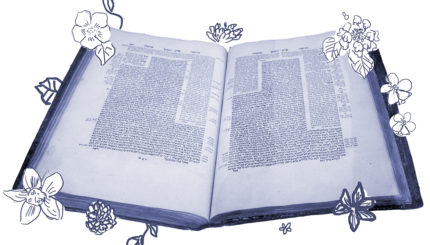First Maccabees (written circa 134-104 BCE and describing the period of 166-135 BCE) is devoted to presenting the Maccabean dynasty, from Mattathias through his son Judah, to Jonathan and Simon who became high priests and gained political independence.
First Maccabees was written in Hebrew (though it is only preserved today in Greek) for a Judean audience in a Biblical style that emphasizes how God chose the Hasmonean family to save Israel. First Maccabees is in a way reminiscent of the Book of Judges (the Maccabees are “those men into whose hand the salvation of Israel was given” [I Maccabees 5:62]). Many original prayers, speeches, and poems embedded in First Maccabees reflect the strong religious feelings of the new rulers.
“Praise the God who planted the seed of the House of David! Praise the God who chose the children of Zadok the priest.” (Ben Sira/Ecclesiasticus 51:28-29)
(1) Mattathias is not a direct descendant of the Zadok family of high priests chosen in the days of David, with whose descendants Jason and Alcimus were implicated in the Hellenist reforms in the Temple.
(2) The Hasmonean dynasty of priests cannot be the descendants of King David who came from the tribe of Judah.
With your help, My Jewish Learning can provide endless opportunities for learning, connection and discovery.
However, the narrative of First Maccabees implicitly answers these objections:
(1) The author describes Mattathias’ action and his rallying call, “Let everyone who is zealous for the Law and who remains faithful to the Covenant, follow me”( I Maccabees 2:27).He uses terms directly analogous to Moses and the Levi tribe at the Golden Calf and Pinchas the zealous priest. They both attacked public desecrators of Jewish worship. In the Bible both the tribe of Levi and Pinchas himself are rewarded for their zealous action by being granted a special status in the Temple worship. Pinchas is even promised what most commentators understand as the high priesthood. Similarly, in Mattathias’s case, zealous action in the face of desecration earns the volunteer the dynastic right to the priesthood for their children after them.
(2) Second Maccabees legitimates the political claims of the Hasmonean dynasty by describing at length the people’s assembly that ratified Simon’s claim to the high priesthood and the governorship. The Greek Syrians acknowledge Simon’s claim by granting him the “purple cloth and the gold clasp,” while the Jewish people immortalize their agreement to Simon’s rule by engraving the agreement on brass tablets set in pillars on Mount Zion. Yet Simon never claimed to displace David’s house, therefore he never took the title “king” and left the agreement as a temporary one “until the true prophet will come.” (I Maccabees 14:41) First Maccabees also emphasizes the international recognition accorded the Hasmonean declaration of independence by quoting no less than nine royal documents from Greek Syria, Rome, and Sparta. (This concern for legitimacy recalls the Zionist concern to obtain the Balfour Declaration, November 2, 1917, and the United Nations recognition on November 29, 1947.)
Interestingly enough, First Maccabees plays down the religious and political civil war that the Maccabees fought with the Zadokite priests and the Hellenizers. Rather it emphasizes the unity of the people around the inspiring religious figure of Judah the Maccabee who is described as a heros (military warrior) and soter (savior of his political community). The true villain is Antiochus IV — the emperor who seeks to homogenize his empire’s many ethnic and religious groups into one loyal Hellenistic kingdom. (“The king ordered all his kingdom to become one people.” [I Maccabees 1:44])
Probably the author of First Maccabees supported the Hasmonean court and believed his book continued the biblical tradition of Chronicles.
Reprinted with permission from A Different Light: The Big Book of Hanukkah published by the Shalom Hartman Institute and Devora Publishing.
Explore Hanukkah’s history, global traditions, food and more with My Jewish Learning’s “All About Hanukkah” email series. Sign up to take a journey through Hanukkah and go deeper into the Festival of Lights.
Hanukkah
Pronounced: KHAH-nuh-kah, also ha-new-KAH, an eight-day festival commemorating the Maccabees' victory over the Greeks and subsequent rededication of the temple. Falls in the Hebrew month of Kislev, which usually corresponds with December.



